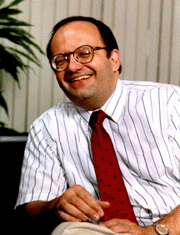Moore's Law Meets Physiology: The Future of Interactive Systems
 Dan Olsen, Brigham
Young University
Dan Olsen, Brigham
Young University
olsen@cs.byu.edu
Seminar on People, Computers,
and Design
Stanford University February 8, 2001
When the graphics frame buffer became cheap enough to be standard on every workstation and Xerox/Apple developed the desktop metaphor of interaction most human-computer interaction research focused on that model. The desktop metaphor has been exhaustively explored, while Moore's Law of computing capacity has marched on. If we consider the next 10 years of computing growth and compare that against the static capacities of human beings, where does that lead us in terms of human-computer interaction. Where are the next targets of opportunity?
Dan Olsen is a professor of Computer Science and Brigham Young University. He has worked extensively in the field of user interface software tools and techniques and has published numerous articles in this area. He most recent work is on the ICE (Interactive Computing Everywhere) project that is attempting to push interactive user interfaces into a variety of new physical and social situations. He has previously served as the founding editor-in-chief of ACM's Transactions on Computer Human Interaction and as SIGCHI Vice Chair of Finance and later Publications. He has also served as chair of the BYU Computer Science Department and director of the Human-Computer Interaction Institute at Carnegie-Mellon University. He has an B.S. and M.S. in Computer Science from Brigham Young University and a Ph.D. in Computer and Information Science from the University of Pennsylvania.
View this talk on line at CS547 on Stanford OnLine
Titles and abstracts for all years are available by year and by speaker.
For more information about HCI at Stanford see